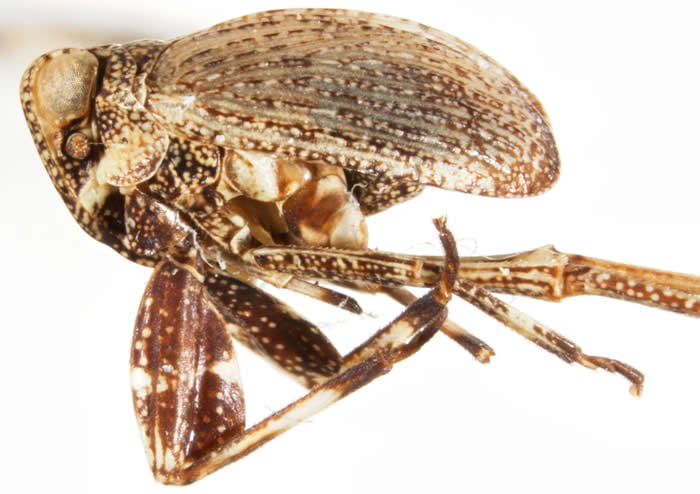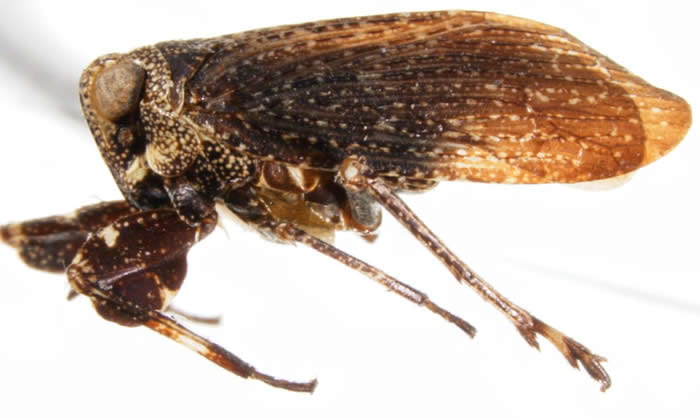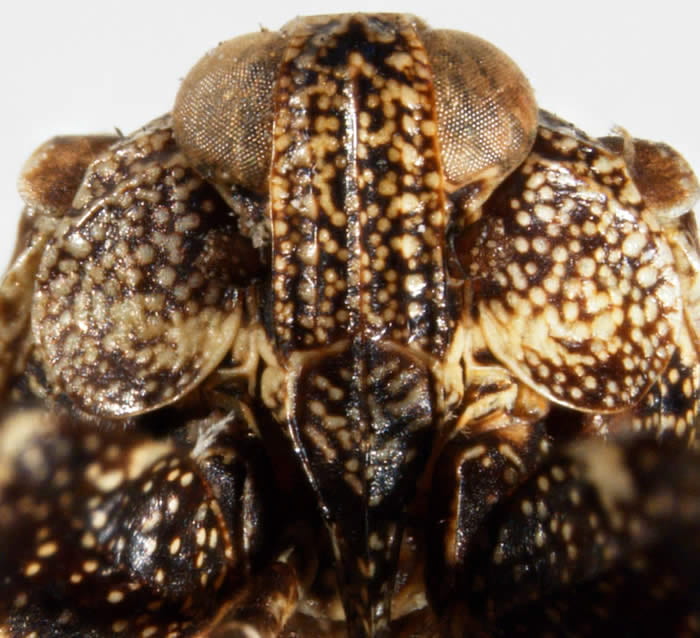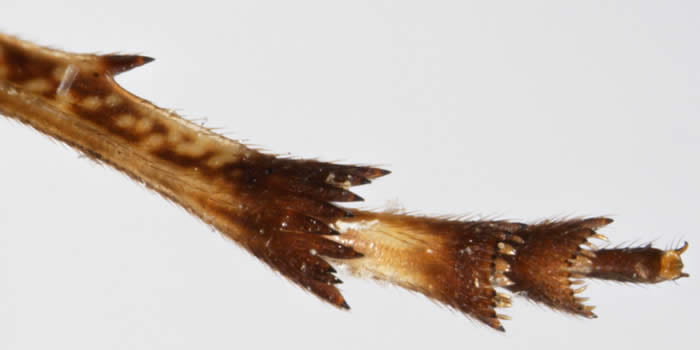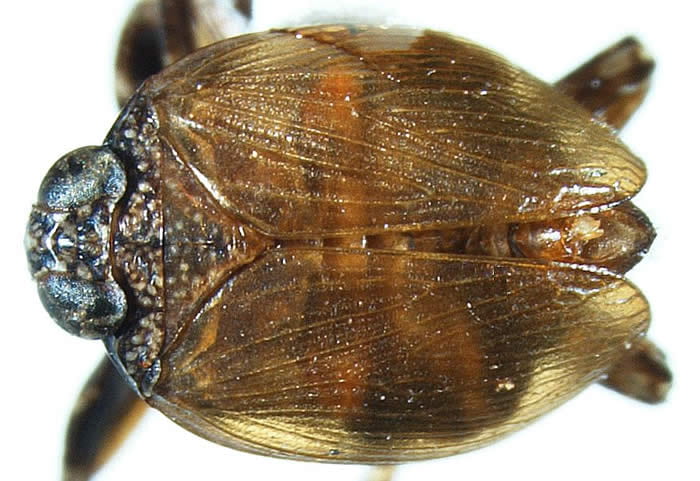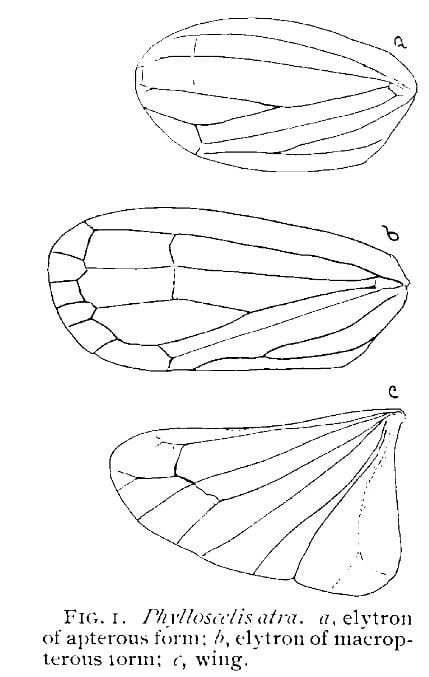[Back to North American Dictyopharidae]
Contents
Family Dictyopharidae Spinola, 1839
Subfamily Dictyopharinae Spinola, 1839
Tribe Phylloscelini Emeljanov, 1983 (sensu Emeljanov 2011)
Genus Phylloscelis Germar, 1839.
Type species (in original combination): Phylloscelis pallescens Germar, 1839.
Synonyms: None.
Distribution:
Widespread but local over much of the US (esp. east), with a few records in Mexico.
Recognized species
Members of this genus are sometimes called ‘toadhoppers’. There are 4 recognized species [see Metcalf 1946: 114].
Phylloscelis atra Germar, 1839 (the cranberry toad bug) – USA: AL, AR, CT, DC, FL, GA, IL, IN, KS, KY, LA, MA, MD, MI, MO, MS, NC, NE, NJ, NY, OH, OK, PA, SC, TN, TX, VA, WV; CAN: ON; Mexico
= Phylloscelis atra var. albovenosa Melichar 1906: 179; syn. by McPherson & Wilson 1995: 181.
= Phylloscelis atra var. ocala Ball 1930: 193; syn. by McPherson & Wilson 1995: 181.
Phylloscelis pallescens Germar, 1839 – USA: AR, FL, IA, IL, KS, KY, LA, MA, MD, MI, MO, MS, NC, NJ, NY, OH, PA, TX, VA; CAN: ON; Mexico
Phylloscelis pennata Ball, 1937 – USA: TX; Mexico (Nuevo León)
Phylloscelis rubra Ball, 1930 – USA: FL, MS, NC, NJ, NY
= Phylloscelis rubra var. nigra Ball 1930:194; syn. by McPherson & Wilson 1995: 182.
Economic Importance:
Limited, although Phylloscelis rubra, the ‘cranberry toad bug‘ is of some importance on cranberries.
Known host plants:
- Phylloscelis atra – Rhus copallina L. (winged sumac, Anacardiaceae)
- Phylloscelis pallescens – Pycnanthemum tenuifolium Schrad. (narrowleaf mountainmint; Lamiaceae)
- Phylloscelis pennata – Solanum sp. (nightshade, Solanaceae)
- Phylloscelis rubra – Vaccinium macrocarpon Aiton (cranberry. Ericaceae)
Hosts from Donovall (2008) and Wilson et al. (1993, 1994); plant names from USDA PLANTS or Tropicos.
Recognition:
Distinctive – dark, stout, usually brachypterous with enlarged legs and head not projected. McPherson & Wilson 1995a provided descriptions and key to species, McPherson 1995b provides descriptions of immatures.
Key to the Species of Phylloscelis from McPhearson and Wilson (1995); figure references to that paper (some OCR problems still to correct).
1 Body dark brown to black … 2
1- Body reddish, cream colored, light brown or black with yellow markings … 3
2 Dark brown to black; carina of frons weak and longitudinal veins, M and CuA1 cells large; anal tube angled in ventrally posterior 1/2 (Figs. 11B, 12C, 13A, 16C) … P. atra
2- Black with cream colored spots on frons and clypeus; carina of frons distinct fading, dorsally; mesonotal wings more than 10 longitudinal veins, cells not as above; anal tube not as above (Figs. 11A, 12A, 14A, 16F, G) … P. rubra
3 Body yellow, mesonotal wings black with yellow veins, 8 longitudinal veins, M and CuA1 cells large, anal tube angled ventrally in posterior half; male, endosome bulbous, smooth, bifurcating to just dorsolateral of endosomal process; female with width of median gonapophysis of the 9th abdominal segment narrowest portion at least 2/3X width of widest distal portion, dIstal process angled ca. 45° narrowing strongly toward apex; gonapophysis of the 8th abdominal segment, in lateral view, with basal most tooth short and weak … P. atra
3- Body reddish, cream or light brown; mesonotal wings, if dark colored, without yellow veins, and with 10 or more longitudinal veins; anal tube almost straight, male, endosoma, if smooth, does not bifurcate, female with width of median gonapophysis of the 9th abdominal segment narrowest portion at least 3/4X width of widest distal portion, distal process angled ca. 30° or less; gonapophysis of the 8th abdominal segment, in lateral view, with basal most tooth either distinct or rudimentary … 4
4.. Body reddIsh; branches of anterior cubitus of mesonotal wings with numerous cross-veins; male endosoma bulbous with many folds, blfurcating into distinct lateral processes; female median gonapophysis of the 9th abdominal segment narrowing strongly toward apex; gonapophysis of the 8th abdominal segment, in lateral view, with basalmost tooth rudimentary (Figs. IIA. 12A, 14B, 15B) … P. rubra
4- Body cream colored to brown, generally with numerous cream colored spots; branches of anterior cubitus of the mesonotal wings with few to no cross-veins; male endosoma with few to no folds and not bifurcating into distinct lateral processes; female median gonapophysis of the 9th abdominal segment almost truncate, slightly rounded toward apex; median gonapophysis of the 8th abdominal segment with basal most tooth pronounced … 5
5 Body brown with numerous cream colored spots; carina of frons distinct and entire; anterior cubitus 2 vein of mesonotal wing branching in basal 173, cross-venation between most veins in distal 1/2; male dorsal process of style in distal 114, process 1I4X height of style; endosoma smooth with no dorsally raised process in lateral view, aedeagus diameter I/6X length, female gonapophysis of the 9th abdominal segment almost truncate, slightly rounded toward apex; median gonapophysis of the 8th abdominal segment with basal most tooth pronounced (Figs. 1; 6A,B; 9B,0; 150; 16A) … P. pallescens
5- Body cream colored with brown; longitudinal carina of frons weak and intermittent; media and anterior cubitus 1 veins of mesothoracic wings branching in basal 114, cross venation between most veins in distal 1/4; male dorsal process of style in distal ll2, process ll2X style height; aedeagus diameter 1I4X length; endosome, in lateral view, a raised process beginning ½ aedeagus length ending as a double fold at apex of aedeagus (FIgS. 12B; 14G,I; 16B) … P. pennata
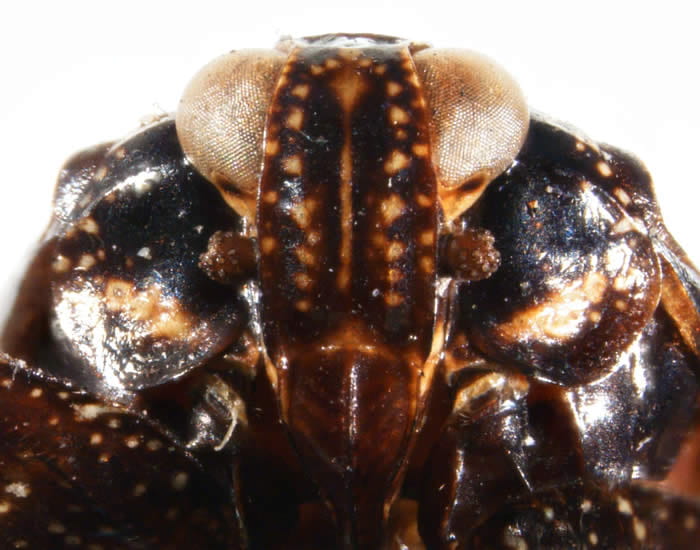
Phylloscelis atra (All photos by Rick Donovall or Kimberley Shropshire, Department of Entomology, University of Delaware) (For P. atra, note that there are fewer veins in the forewing than in P. rubra.)
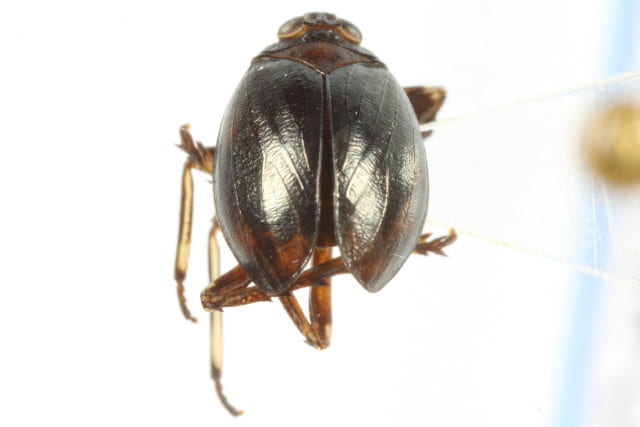
Phylloscelis atra CNC#HEM401790 from BOLD (CNC CC)
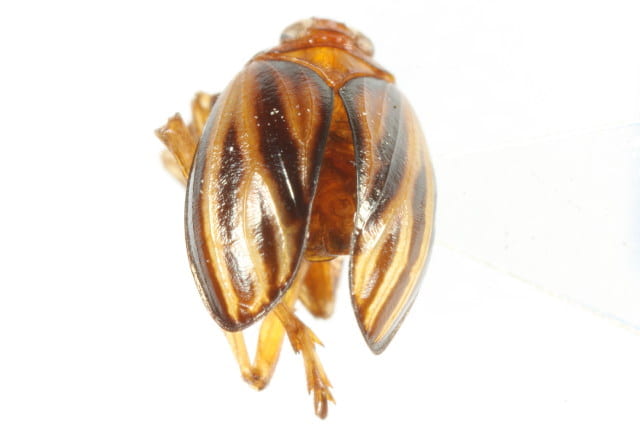
Phylloscelis atra CNC#HEM401791 from BOLD (CNC CC)

Nymph, Phylloscelis atra CNC#HEM401789 from BOLD (CNC CC)
Online resources.
Bugguide.
FLOW.
BOLD.
GBIF.
Discover Life.
EOL.
3I Interactive Keys and Taxonomic Databases (Dmitry Dmitriev)
Hoppers of North Carolina.
Maryland database project.
Collecting
Collected infrequently, but sometimes in numbers, by sweeping or inspecting hosts; P. atra is an occasional pest of cranberry.
Molecular resources:
As of this writing (2 Oct. 2018), data for 2 species of this genus is available on Genbank. Three species of Phylloscelis (P. atra, pallescens, and rubra) are available on Barcode of life.
Selected references:
Ball, E. D. 1909d. Some remarkable new leafhoppers of the family Fulgoridae. Proceedings of the Biological Society of Washington 22: 197-204.
Ball, E. D. 1930. The toadhoppers of the genus Phylloscelis Germ. (Rhynchota Fulgoridae). Canadian Entomologist 62: 192-195.
Ball, E. D. 1937. Some New Fulgoridae from the Western United States. Bulletin of the Brooklyn Entomological Society 32(5): 171-183.
Britton, W. E. 1923a. Guide to the insects of Connecticut. Part IV. The Hemiptera or sucking insects of Connecticut. Bulletin. State of Connecticut. State Geological and Natural History Survey 34: 1-807. (see p. 28) [E. P. Van Duzee, Family Fulgoridae, Pp. 24-55)
Donovall, L. R., III. 2008. A generic revision of the new world Dictyopharinae (Hemiptera: Dictyopharidae). Masters Thesis. University of Delaware, Newark, Delaware.
Doering, K. C. 1955. Some taxonomic and morphological studies of two genera of North American Dictyopharidae. University of Kansas Science Bulletin 37(7): 195-221.
Doering, K. C. 1956. The taxonomic value of the pretarsal structures in the classification of certain Fulgoroidea. University of Kansas Science Bulletin 37: 627-643.
Emeljanov, A. F. 1983. Dictyopharidae from the Cretaceous deposits on the Taymyr Peninsula (Insecta, Homoptera). Paleontologicheskii Zhurnal 3: 79-85 [In Russian; translated in: Paleontological Journal 17(3): 77-82].
Emeljanov, A. F. 2011. Improved tribal delimitation of the subfamily Dictyopharinae and description of new genera and new species (Homoptera, Fulgoroidea, Dictyopharidae). Ėntomologicheskoe Obozrenie 90(2): 299-328 [In Russian, English Translation, Entomological Review 91(9): 1122-1145].
Fennah, R. G. 1944. New Dictyopharidae from the New World (Homoptera : Fulgoroidea). Proceedings of the Biological Society of Washington 57: 77-94.
Germar, E. F. 1839. Drei neue Gattungen der Cicadinen, aufgestellt vom herausgeber. Zeitschrift für die Entomologie, herausgegeben von E. F. Germar. Leipzig 1: 187-192.
Heaton, R. R. 1934a. An annotated list of the Fulgoridae (Homoptera) of Indiana. Bulletin of the Brooklyn Entomological Society 29: 107-115.
McPherson, K. R. 1994. The dictyopharid planthopper genus Phylloscelis in the United States with notes on the biology and immatures of P. pallescens (Homoptera: Fulgoroidea). Thesis, Central Missouri State University. Master’s Thesis. 84 pp.
McPherson, K. R. and S. W. Wilson. 1995a. The planthopper genus Phylloscelis in the United States (Homoptera: Dictyopharidae). Insecta Mundi 9: 177-188.
McPherson, K. R. and S. W. Wilson. 1995b. Life history and descriptions of immatures of the dictyopharid planthopper Phylloscelis pallescens (Homoptera: Fulgoroidea). Journal of the New York Entomological Society 103: 170-179.
Melichar, L. 1912a. Monographie der Dictyophorinen (Homoptera). Abhandlungen der K. K. Zoologisch-botanischen Gesellschaft in Wien. 7 (1): 1-221. Plate(s): 1-5. (see p. 173)
Metcalf, Z. P. 1913b. The wing venation of the Fulgoridae. Annals of the Entomological Society of America 6: 341-352.
Metcalf, Z. P. 1923. A key to the Fulgoridae of eastern North America with descriptions of new species. Journal of the Elisha Mitchell Scientific Society 38(3): 139-230, plus 32 plates. [available from http://www.lib.unc.edu/dc/jncas/].
Metcalf, Z. P. 1946. General Catalogue of the Homoptera. Fascicle IV Fulgoroidea. Part 8 Dictyopharidae. Smith College, Northhampton, Massachusetts. (see p. 114)
Osborn, H. 1904b. Notes on alate form of Phylloscelis. Ohio Naturalist 4: 93-94. [Dictyopharidae]
Oshanin, V. T. 1913a. Synopsis der Tribus Orgeriiaria der russischen Fauna. (Hemiptera-Homoptera). Revue Russe d’Entomologie 13: 135-147. [Keys to the genera and species with bibliographic and synonymical catalog.]
Rodriguez-Saona, C. 2014. Cranberry Toad Bug: A New Cranberry Pest. Plant & Pest Advisory, Rutgers Cooperative Extension. 2 pp. plant-pest-advisory.rutgers.edu-Cranberry Toad Bug A New Cranberry Pest.
Scammell, H. B. 1917. Cranberry insect problems and suggestions for solving them. Farmers’ Bulletin. United States Department of Agriculture 860: 1-45. [Phylloscelis]
Sirrine, F. A. and B. B. Fulton. 1914. The cranberry toad bug. New York Agricultural Experiment Station Bulletin 377: 91-112. (http://hdl.handle.net/1813/4749).
Smith, J. B. 1910a. Order Homoptera. Pp. 87-130. In: A report of the insects of New Jersey. Annual Report of the New Jersey State Museum 1909:1-888. (PDF only to end of Auchenorrhyncha, p. 107; see link to BHL for whole volume) (see p. 94-98)
Van Duzee, E. P. 1916a. Check list of Hemiptera (excepting the Aphididae, Aleurodidae and Coccidae) of America North of Mexico. New York Entomological Society, New York. 111 pp. [see p. 78 onward]
Van Duzee, E. P. 1917b. Catalogue of the Hemiptera of America North of Mexico (excepting the Aphididae, Coccidae and Aleurodidae). University of California Publications, Technical Bulletins, vol. 2. University of California Press, Berkeley, pp. i-xiv, 1-902. [from Google books] [see p. 716 onward] (see. p. 723)
Weiss, H. B. 1915a. Additions to insects of New Jersey. Entomological News 26: 101-107.[Phylloscelis atra noted]
Wilson, S. W., J. L. Smith and P. D. Calvert. 1993. Planthoppers of a Missouri tallgrass prairie (Homoptera: Fulgoroidea Journal of the Kansas Entomological Society 66: 75-80.
Wilson, S. W., C. Mitter, R. F. Denno and M. R. Wilson. 1994. Evolutionary patterns of host plant use by delphacid planthoppers and their relatives. In: R. F. Denno and T. J. Perfect, (eds.). Planthoppers: Their Ecology and Management. Chapman and Hall, New York. Pp. 7-45 & Appendix.




